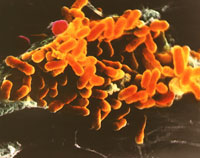Epidemic typhus
|
|
| Rickettsia prowazekii | ||||||||||||||
|---|---|---|---|---|---|---|---|---|---|---|---|---|---|---|
 | ||||||||||||||
| Scientific classification | ||||||||||||||
| ||||||||||||||
| Binomial name | ||||||||||||||
| Rickettsia prowazekii |
Epidemic typhus is a form of typhus caused by the bacillus Rickettsia prowazekii, carried by the human body louse Pediculus humanus. Feeding on a human who carries the bacillus infects the louse. R. prowazekii grows in the louse's gut and is excreted in the feces. The disease is transmitted to an uninfected human who scratches the bite and rubs the feces into the wound. Incubation period is one to two weeks. R. prowazekii can remain viable and virulent in the dried feces for many days. The disease will kill the louse and it will remain viable for many weeks in the dead louse.
Brill-Zinsser disease is a type of epidemic typhus which recurs in someone after a long period of latency (similar to the relationship between chickenpox and shingles). This type of recurrence can also occur in immunosuppressed patients.
Before World War II, epidemic typhus was a devastating disease for humans. Epidemics occurred throughout Europe from the 17th to the 19th centuries. It was common in prisons, where it was known as Gaol Fever. Before then there is little historical literature available. Widespread epidemics occurred during the Napoleonic Wars and the Irish potato famine of 1846 to 1849. During World War I the disease caused three million deaths in Russia and more in Poland and Romania. Even larger epidemics in the post-war chaos of Europe were only averted by the widespread use of the newly discovered DDT to kill the lice on millions of refugees and displaced persons. A vaccine was also developed in World War II, and today epidemics only occur in Eastern Europe, the Middle East and parts of Africa where living conditions and hygiene are poor.
According to Waclaw Szybalski [1] (http://www.lwow.home.pl/Weigl.html), the first description of typhus was given in 1083 in a convent near Salerno, Italy. In 1546, Girolamo Fracastoro, a Florentine physician, gave another description of typhus in his famous treatise on viruses and contagion, "De Contagione et Contagiosis Morbis."
Development of the Vaccine
Epidemic_typhus_Burundi.jpg
The first major step in the development of the vaccine was Charles Nicolle's 1909 discovery that lice were the vectors for epidemic typhus. This made it possible to isolate the bacteria causing the disease and develop a vaccine. Nicolle attempted a vaccine but was not successful in making one that worked on a large enough scale. He won the 1928 Nobel Prize for this work.
Henrique da Rocha Lima in 1916 then proved that the bacteria Rickettsia prowazekii was the agent responsible for typhus; he named bacteria after H. T. Ricketts and Stanislaus von Prowazek, two zoologist who died investigating a typhus epidemic in a prison camp in 1915.
Once these crucial facts were recognized, Rudolf Weigl in 1930 was able to fashion a practical and effective vaccine production method by grinding up the guts of infected lice that had been drinking blood. It was, however, very dangerous to produce, and carried a high likelihood of infection to those who were working on it.
A safer, mass-production-ready method was determined by Herald R. Cox in 1938, involving egg yolk, and this was tested and put into heavy use by 1943.
Epidemics
Epidemic typhus is responsible for a number of epidemics throughout history. It tends to follow after wars, famine and other problems that cause mass deaths (and therefore crowded conditions and lice).
- It is believed responsible for the plague of Athens in 430 BC
- During Napoleon's retreat from Moscow in 1812, more French soldiers died of typhus than were killed by the Russians
- Struck in Philadelphia in 1837
- Killed the son of Franklin Pierce in Concord, New Hampshire, 1843
- Many died of typhus during and after Irish potato famine in 1846
- One of several epidemics in Baltimore, Memphis and Washington DC from 1865-1873
- Between 1918 and 1922 it was responsible for at least 3 million deaths out of 20-30 million cases
- Struck the German army when it invaded Russia in 1941
- Killed inmates in the Nazi Germany concentration camps. (The infamous pictures of typhus victims' mass graves from Bergen-Belsen concentration camp)
- 1942, 1943 - hit French North Africa, Egypt and Iran particularly hard [2] (http://history.amedd.army.mil/booksdocs/wwii/infectiousdisvolii/chapter7.htm)
References
- Rats, Lice and History (1934), by Hans Zinsser, a rather idiosyncratic history of the disease and its epidemiology by a bacteriologist who developed a mass production method for the typhus vaccine. ISBN 1884822479
- De Contagione et Contagiosis Morbis (1546), by Girolamo Fracastoro, one of the first descriptions of typhus
- Nature 396, pp. 109 - 110 (12 November 1998) (http://www.nature.com/cgi-taf/DynaPage.taf?file=/nature/journal/v396/n6707/full/396109a0_fs.html) by Michael W. Gray
- Nuernberg Military Tribunal, Volume I, pp. 508-511 (http://www.mazal.org/archive/nmt/01/NMT01-T508.htm)
- Neurnberg Military Tribunal, Volume II, pp. 69-70 (http://www.mazal.org/archive/nmt/02/NMT02-T0069.htm)
- How Charles Nicolle of the Pasteur Institute discovered that epidemic typhus is transmitted by lice: reminiscences from my years at the Pasteur Institute in Paris (http://www.pnas.org/cgi/reprint/93/20/10539.pdf) by Ludwik Gross, August 6, 1996
- Internal Medicine in World War II, Volume II, Chapter 7 (http://history.amedd.army.mil/booksdocs/wwii/infectiousdisvolii/chapter7.htm) - information on the Cox vaccination trials by Chris J. D. Zarafonetis, M.D., along with statistics on the disease
- Nature 396, 109 - 110 (12 November 1998) (http://www.nature.com/cgi-taf/DynaPage.taf?file=/nature/journal/v396/n6707/full/396109a0_fs.html) by Michael W. Gray
- Weigl's method of intrarectal inoculation of lice in production of typhus vaccine and experimental works with Rickettsia Prowazeki (http://www.lwow.home.pl/Weigl/krynski/teoria.html) by Stefan Krynski, Eugeniusz Becla, Marian Machel
- Maintenace of human-fed live lice in the laboratory and production of Weigl's exanthematous typhus vaccine (http://www.lwow.home.pl/Weigl.html) by Waclaw Szybalskide:Fleckfieber
